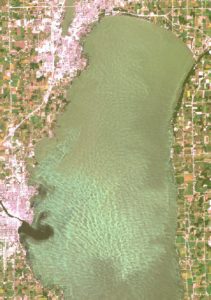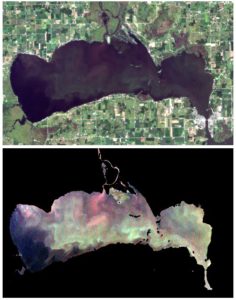Phosphorus is a naturally occurring element in our environment and is essential to all living organisms. In Wisconsin’s lakes, rivers, and streams, phosphorus serves as a foundational element of the food chain by supporting algae and plant growth. Algae and plants support lower fish and invertebrates, which serve as food for birds, mammals, and fish. However, the air and our water bodies can become polluted when phosphorus input exceeds normal levels. These events have far reaching environmental, public health, and economic issues. This excess input comes primarily from agricultural and lawn fertilizers, industrial cleaners, and wastewater.

2000 Lake Winnebago algal bloom. Photo: UW SSEC and WisconsinView
Environmental Impacts
Algae negatively impacts water quality when high levels of phosphorus and nitrogen in the water allow algae to grow faster than the aquatic system can normally handle. Blue-green algae species lack the ecological “checks and balances” that keep, for example, green-algae levels at normal levels. Large, concentrated growths of algae reduce sunlight availability to plants minimizing photosynthesis, which is an oxygen producing biological process. Then, when the algal mats die and sink to the bottom, the decomposition process consumes the remaining oxygen. This hypoxic condition causes illness and death in aquatic organisms, or forces aquatic life elsewhere. The influx of migrants puts strains the resources of the system taking in the new users.
Public Health Impacts
Algal blooms can be hazardous to humans as well. Not all blue-green algae produce toxins, and not algae capable of producing toxins will produce them. When produced, these toxins can cause illness in humans and pets. Common routes of exposure include swimming in and drinking affected water, as well as eating affected fish. Additionally, toxic aerosols can be released when algae cell walls are broken, for example, by boat propellers. Testing done in June of 2012 revealed 95 million blue-green algae cells per ml in Lake Winnebago. The World Health Organization recommends caution at levels above 20,000 cells per ml! CLICK HERE to learn more about safety concerns.

1999 Lake Poygan and Lake Winneconne Algal bloom. Photo: UW SSEC and WisconsinView
Economic Impacts
The Winnebago Waterways is a cornerstone of the local economy. A 2007 study revealed that angling along brought in $234 million annually and supports 4300 jobs in the five county region (Winnebago, Calumet, Fond du Lac, Washara, and Outagamie). This economic income is highly dependent on healthy fisheries, which are degraded by nutrient pollution. Additional recreational opportunities impacted by nutrient pollution include boating, swimming, diving, hunting, hiking, and paddling, all of which draw tourists in from around the state and region. Lastly, nutrient pollution can contribute to decreased property values in the region, especially for areas bordering affected water bodies.
Where does it come from?
Phosphorus input can be classified as internal loading or external loading. External loading includes agricultural inputs, including phosphorus leached from manure and fertilizer, polluted storm water inputs, inadequately treated wastewater, industrial cleaners/detergents, lawn fertilizer, and yard waste (phosphorus in leaves and grass clippings). Internal loading occurs when phosphorus in lake sediment is released into the water due to various mechanical, chemical, and biological processes. Lake Winnebago’s shallow profile allows wave and boat action to stir up pollutant laden bottom sediments. However, aquatic plants can help mitigate this because their roots anchor down sediment.
What is being done about it?
Recovery efforts in the Winnebago Lakes, guided by the Winnebago Waterways Lake Management Plan, are working to reduce phosphorus pollution in our lake system. CLICK HERE to read more about efforts in the Winnebago Waterways.
More resources:
Lakeshore Property Values and Water Quality: Evidence from Property Sales in the Mississippi Headwaters Region
https://www.epa.gov/nutrientpollution/problem





